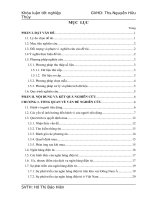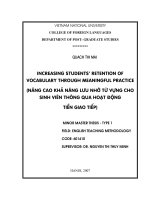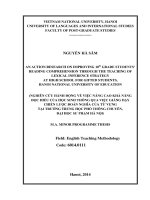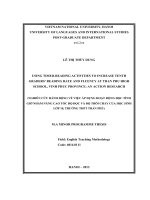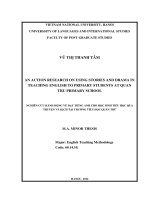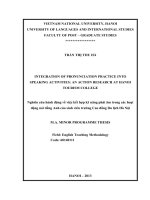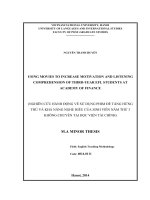Một nghiên cứu hành động về việc sử dụng thuật cải thiện trí nhớ trong việc nâng cao khả năng ghi nhớ từ vựng cho sinh viên hệ cao đẳng chính quy
Bạn đang xem bản rút gọn của tài liệu. Xem và tải ngay bản đầy đủ của tài liệu tại đây (1.65 MB, 102 trang )
VIETNAM NATIONAL UNIVERSITY, HANOI
UNIVERSITY OF LANGUAGES AND INTERNATIONAL STUDIES
FACULTY OF POST-GRADUATE STUDIES
***********************
TẠ THU HẰNG
AN ACTION RESEARCH PROJECT ON USING MNEMONICS IN
IMPROVING VOCABULARY RETENTION FOR THE FORMAL
COLLEGE STUDENTS IN COLLEGE OF INDUSTRIAL TECHNIQUES
(BAC GIANG PROVINCE) IN THE ACADEMIC YEAR 2015-2016
(MỘT NGHIÊN CỨU HÀNH ĐỘNG VỀ VIỆC SỬ DỤNG THUẬT CẢI
THIỆN TRÍ NHỚ TRONG VIỆC NÂNG CAO KHẢ NĂNG GHI NHỚ TỪ
VỰNG CHO SINH VIÊN HỆ CAO ĐẲNG CHÍNH QUY, TRƯỜNG CAO
ĐẲNG KỸ THUẬT CÔNG NGHIỆP (TỈNH BẮC GIANG) TRONG
NĂM HỌC 2015-2016)
M.A. MINOR PROGRAMME THESIS
Field: English Teaching Methodology
Code: 60140111
HANOI – 2017
VIETNAM NATIONAL UNIVERSITY, HANOI
UNIVERSITY OF LANGUAGES AND INTERNATIONAL STUDIES
FACULTY OF POST-GRADUATE STUDIES
***********************
TẠ THU HẰNG
AN ACTION RESEARCH PROJECT ON USING MNEMONICS IN
IMPROVING VOCABULARY RETENTION FOR THE FORMAL
COLLEGE STUDENTS IN COLLEGE OF INDUSTRIAL TECHNIQUES
(BAC GIANG PROVINCE) IN THE ACADEMIC YEAR 2015-2016
(MỘT NGHIÊN CỨU HÀNH ĐỘNG VỀ VIỆC SỬ DỤNG THUẬT CẢI
THIỆN TRÍ NHỚ TRONG VIỆC NÂNG CAO KHẢ NĂNG GHI NHỚ TỪ
VỰNG CHO SINH VIÊN HỆ CAO ĐẲNG CHÍNH QUY, TRƯỜNG CAO
ĐẲNG KỸ THUẬT CÔNG NGHIỆP (TỈNH BẮC GIANG) TRONG
NĂM HỌC 2015-2016)
M.A. MINOR PROGRAMME THESIS
Field: English Teaching Methodology
Code: 60140111
Supervisor: Prof. Nguyễn Hòa
HANOI – 2017
DECLARATION
I, the undersigned, hereby certify my authority of the study project report
entitled “AN ACTION RESEARCH PROJECT ON USING MNEMONICS IN
IMPROVING
VOCABULARY
RETENTION
FOR
THE
FORMAL
COLLEGE STUDENTS IN COLLEGE OF INDUSTRIAL TECHNIQUES
(BAC GIANG PROVINCE) IN THE ACADEMIC YEAR 2015-2016”
submitted in partial fulfillment of the requirements for the Master Degree at
University of Languages and International Studies, Vietnam National University,
Hanoi and that this thesis has not been submitted to any degree at any other
universities or institutions. Except where the reference is indicated, no other
person’s work has been used without due acknowledgement in the text of the thesis.
Hanoi, 2017
Tạ Thu Hằng
i
ACKNOWLEGEMENTS
This thesis could not have been completed without the help and support from
a number of people.
First and foremost, I would like to express my sincere gratitude to Prof.
Nguyễn Hòa, my supervisor, who has patiently and constantly supported me
through the stages of the study, and whose stimulating ideas, expertise, and
suggestions have inspired me greatly through my growth as an academic
researcher.
A special word of thanks goes to my colleagues at my working place and
many others, without whose support and encouragement it would have never been
possible for me to have this thesis accomplished.
Last but not least, I am greatly indebted to my family members for the
sacrifice they have devoted to the fulfillment of this academic work.
ii
ABSTRACT
This study aims to investigate the effectiveness of the four mnemonic
strategies in short-term and long-term vocabulary retention of formal college
students. With the use of the pre-tests, the post-tests and the questionnaire, 22
college students in College of Industrial Techniques (Bac Giang province) were
randomly assigned into the control group and the experimental group, in which the
control group was taught 69 items in three teaching sessions with the traditional
vocabulary instruction of repeating, translation and example sentence explanation
while the experimental group was received these vocabulary items with the four
mnemonic devices named keyword method, visual mnemonic (pictures), grouping
or semantic organization and physical response method. The results indicated that
after the treatment, the four mnemonic strategies were really effective in vocabulary
retention for students; the participants from the experimental group showed their
improvement in recalling vocabulary items in short-term and long-term better than
those from the control group. Moreover, the participants’ attitudes towards the
training scheme and the four used memory strategies were also discussed.
iii
TABLE OF CONTENTS
Declaration .................................................................................................................. i
Acknowlegements ...................................................................................................... ii
Abstract ..................................................................................................................... iii
Table of contents ....................................................................................................... iv
List of tables and figures .......................................................................................... vii
PART 1 – INTRODUCTION ...................................................................................1
1.1.
Rationale of the Study ...................................................................................1
1.2.
Aims and objectives of the study...................................................................2
1.3.
Statement of the research questions ..............................................................2
1.4.
Scope of the study..........................................................................................3
1.5.
Significance of the study ...............................................................................3
1.6.
Method of the study .......................................................................................4
PART 2- LITERATURE REVIEW AND THEORETICAL BACKGROUND .6
2.1. Vocabulary ........................................................................................................6
2.1.1.Definition .....................................................................................................6
2.1.2.Types of vocabulary.....................................................................................6
2.1.3.Importance of vocabulary ...........................................................................7
2.1.4.Ways and strategies to teach vocabulary ....................................................8
2.1.5.Vocabulary retention and memory ............................................................10
2.2. Mnemonics......................................................................................................11
2.2.1.Definition ...................................................................................................11
2.2.2. Classification of mnemonics .....................................................................11
2.2.3. Efficiency of using mnemonics for information and vocabulary retention
and recall ............................................................................................................15
PART 3 - RESEARCH METHODOLOGY .........................................................19
3.1. Restatement of research questions ..................................................................19
3.2.
Context of the study.....................................................................................19
iv
3.2.1.
Setting of the study ................................................................................19
3.2.2.
Participants - Subject of the study ........................................................21
3.3.
Implementation of the Action Research ...................................................23
3.4.
Research design ...........................................................................................24
3.5.
Research instruments ...................................................................................30
3.5.1. Tests ..........................................................................................................31
3.6.
Data analysis procedure ...............................................................................34
PART 4 - DATA ANALYSIS AND DISCUSSION ..............................................35
4.1. The result of the homogeneity test..................................................................35
4.2. Research question 1 (Identifying the problems): What are the problems that
the students encounter in their vocabulary retention? ...........................................35
4.3. The result of pre-test 2 ....................................................................................36
4.4. Research question 2: Is mnemonics effective in improving short-term
vocabulary retention for the formal college students of College of Industrial
Techniques in the academic year 2015-2016? .......................................................37
4.4.1. Results from the immediate post-test 1 .....................................................37
4.4.2. Result from the immediate post-test 2 ......................................................39
4.4.3. Result from the immediate post-test 3 ......................................................41
4.5. Research question 3: Is mnemonics effective in improving long-term
vocabulary retention for the formal college students of College of Industrial
Techniques in the academic year 2015-2016? .......................................................44
4.6.
Research question 4: What are the students’ attitudes towards using
mnemonic strategies in vocabulary retention? ......................................................46
4.6.1 The participants’ attitudes towards the strategy training scheme ............46
4.6.2. The participants’ interest towards the four mnemonic strategies ............49
PART 5 – CONCLUSION ......................................................................................51
5.1. Summary .........................................................................................................51
5.2. Conclusion ......................................................................................................52
5.3. Implications ....................................................................................................53
v
5.4. Limitations of the study ..................................................................................53
5.5. Suggestions for further study ..........................................................................54
REFERENCES ........................................................................................................55
APPENDICES ........................................................................................................... I
APPENDIX 1: ............................................................................................................ II
APPENDIX 2: ......................................................................................................... XII
APPENDIX 3: .................................................................................................... XVIII
APPENDIX 4: ................................................................................................... XXVII
APPENDIX 5: .....................................................................................................XXIX
vi
LIST OF TABLES AND FIGURES
Table 1: Nation’s vocabulary learning strategies (Nation, 2001)
Table 2: The schedule of the action implementation
Table 3: Results from pre-test 1
Table 4: Result of the control group in the immediate post-test 1
Table 5: Result of the experimental group in the immediate post-test 1
Table 6: Result of the control group in the immediate post-test 2
Table 7: Result of the experimental group in the immediate post-test 2
Table 8: Result of the control group in the immediate post-test 3
Table 9: Result of the experimental group in the immediate post-test 3
Table 10: Result of the control group in the delayed post-test
Table 11: Result of the experimental group in the delayed post-test
Table 12: Importance of the strategy training scheme
Table 13: Effectiveness of the strategy training scheme
Table 14: Pleasure during the strategy training scheme
Table 15: Student’ preference of four mnemonic strategies
Figure 1: Action research cycle
Figure 2: Results from pre-test 1
Figure 3: Result of selection between the control and experimental groups in the
immediate post-test 1
Figure 4: The overall performance between the control group and the experimental
group in the immediate post-test 1
Figure 5: Result of selection between the control and experimental groups in the
immediate post-test 2
Figure 6: The overall performance between the control group and the experimental
group in the immediate post-test 2
Figure 7: Result of selection between the control and experimental groups in the
immediate post-test 3
vii
Figure 8: The overall performance between the control group and the experimental
group in the immediate post-test 3
Figure 9: The general performance between the control group and the experimental
group in all the immediate post-tests
Figure 10: Result of selection between the control and experimental groups in the
delayed post-test
Figure 11: The overall performance between the control group and the
experimental group in the delayed post-test
Figure 12: Importance of the strategy training scheme
Figure 13: Effectiveness of strategy training scheme
Figure 14: Pleasure during the strategy training scheme
viii
PART 1 – INTRODUCTION
In this part, I will present the rationale, the aims and objectives, the statement of
the research question, the scope, the significance, the method and the structural
organization of the study.
1.1. Rationale of the Study
For the past 20 years in Vietnam, English has become very important in many
aspects of life and the activity of teaching and learning English is also paid much
more attention to as well. In order to learn English well, together with the
investment in improving English skills such as listening, reading, writing, speaking,
the role of vocabulary and vocabulary learning cannot be neglected because
vocabulary helps to build up the core of knowledge and it is the foundation to
facilitate the learning. The English learners possibly know how to use the grammar
and structures correctly but without having a sufficient vocabulary, they cannot
speak, write and use English well. Therefore, at any time of English learning,
vocabulary should be given the top priority and major importance. Thornburry
(2002) stressed on the importance of learning words in the course book titled
“Innovations” that “If you spend most of your time studying grammar, your English
will not improve very much. You will see most improvement if you learn more words
or expressions. You can say very little with grammar, but you can say almost
everything with words”. Consequently, it is worth doing research on vocabulary
learning strategies to facilitate the vocabulary learning to enhance English learning
success and achievement.
Secondly, I have been teaching English for more than three years in a technical
college where English is a required subject. Before carrying out this research, I
carried out a test (pre-test 1) with students on how well they can remember the
words and to check whether they could remember the words they had learned as
well as find out their difficulty in remembering words. The result showed that the
biggest problem encountering my students in vocabulary retention was although
they saw the words familiar; they could not retrieve the meanings.
1
This fact
resulted from the lack of necessary techniques for remembering vocabulary. That is
the reason why there should be a study on an effective vocabulary leaning method
for my students. Moreover, there has never been any research or study on improving
vocabulary remembering efficiency for students at my college – College of
Industrial Technique. It is that current situation in my teaching that really
encourages me to find a better way to make my students interested in learning and
remembering new words.
To conclude, the study proceeds from two main reasons. The first lies in
realizing the importance of learning vocabulary to English learners. The second
reason is based on the present circumstance facing my students in vocabulary
retention and the fact that no available research has been carried out in this field at
my college. Therefore, I have chosen to focus on vocabulary learning and teaching
in my study project report to make my students improve their performance of
recalling words.
1.2. Aims and objectives of the study
The main purpose of the study is to investigate the effectiveness of mnemonics
on improving vocabulary retention of the formal college students in College of
Industrial Techniques, Bac Giang city, Bac Giang province.
With the above aim, the specific objectives of this study are as follows:
-
Identify the biggest problems facing students in their vocabulary retention;
-
Investigate the effectiveness of mnemonic devices in short-term vocabulary
retention of students;
-
Investigate the effectiveness of mnemonic devices in long-term vocabulary
retention of students;
-
Find out the students’ attitude towards using mnemonic strategies in
vocabulary retention.
1.3. Statement of the research questions
Based on the above given aim, the objectives and the background of the
research, the research questions can be formulated as follows:
2
a. What are some biggest problems that the students encounter in their
vocabulary retention?
b. To what extent is mnemonics effective in improving short-term vocabulary
retention for the formal college students of College of Industrial Techniques in
the academic year 2015-2016?
c. To what extent is mnemonics effective in improving long-term vocabulary
retention for the formal college students of College of Industrial Techniques in
the academic year 2015-2016?
d. What are the students’ attitudes towards using mnemonic strategies in
vocabulary retention?
1.4. Scope of the study
The study is narrowed to the area of teaching and learning vocabulary for the
formal college students at College of Industrial Techniques, Bac Giang city, Bac
Giang province in the academic year 2015-2016. It was conducted at College of
Industrial Techniques, Bac Giang province. Because of limited time, the thesis only
deals with the current situation of teaching and learning English vocabulary here.
The participants were just the students who are representatives of the whole
formal college students of the college.
1.5. Significance of the study
The study has its own importance in contributing a method for students to
remember and recall vocabulary better and for a longer time than without applying
this method. It provides both of the theoretical and practical significance. In terms
of theory, the study can be used as a reference for improving vocabulary learning
skills and it contributes to the general theory of vocabulary retention improvement
techniques. Students can understand how to remember the new words
systematically and they are able to learn more easily and keep them in their mind in
a longer time, from which they tend to get achievement in learning English.
Moreover, practically, the mnemonic techniques used in this study and the list of
words taught with mnemonics can be discussed and transferred to English teachers
3
and applied in mass in the vocabulary teaching activity at College of Industrial
Techniques, Bac Giang city.
1.6. Method of the study
The study was carried out by some steps as follows:
First, in order to ensure the subject’s homogeneity, the homogeneity test was
implemented to filter the students, from which official study subjects (the
participants) could be chosen.
Secondly, pre-test 1 was carried out with the participants to find out if there
were any existing problems facing them in the process of learning English
vocabulary and how well the participants could remember the words. After that pretest 2 was finished in order to set up a list of words unknown for the participants.
These words would be used later in the teaching activity with mnemonic strategies.
Then the participants were divided into two groups including the control group
and the experimental group. After that, the corrective action was applied with the
participants during the corrective time. The control group was received the
traditional way of vocabulary teaching while the experimental group was taught
with mnemonic devices.
Next, right at the end of each of the three sessions of correction, each immediate
post-test was finished by the students (participants) of both the experimental group
and the experimental one. The result of each immediate post-test of the
experimental group was compared to the respective one of the control group to
show that whether there is an improvement in short-term vocabulary retention by
using mnemonics or not.
In addition, after two weeks from the last session of correction, another delayed
post-test was delivered to both groups to test their long-term vocabulary recall. The
analysis was carried out as same as the procedure of the three immediate post-tests.
After that, a questionnaire survey was conducted to the experimental group’s
participants in order to study their opinion and evaluation on mnemonic techniques
in their vocabulary learning.
4
Then, the data were collected, sorted and analyzed quantitatively and
qualitatively to obtain realistic results.
To end with, pedagogical implications for enhancing students’ performance in
remembering vocabulary will be proposed based on the results found from all data
collection instruments.
1.7. Structural organization of the study
The study consists of five main parts:
Part I - Introduction presents the rationale of the study, the aim & objectives, the
research questions, the significance, the scope, the method and the design of the
study.
Part 2 - Literature Review and Theoretical Background reviews the theories on
vocabulary, vocabulary learning & teaching and mnemonics.
Part 3 – Research Methodology describes the participants, the setting of the study
involving the school, textbook and curriculum. Moreover, this part shows how the
researcher applied the data collection instruments and her procedure of conducting
the study.
Part 4 - Data analysis & Discussion in which the researcher used both qualitatively
and quantitatively method to study and analyze the data and information collected.
Part 5 –Conclusion summarizes all findings explored and brings out useful
suggestions for the teachers to enhance the vocabulary retention of students. An
overall picture of what has been done in this study and suggestions for further
studies are also included in this part.
5
PART 2- LITERATURE REVIEW AND
THEORETICAL BACKGROUND
This part provides a review of literature in theory and practice to the study in
terms of two main contents: Vocabulary and mnemonics.
2.1. Vocabulary
2.1.1.Definition
Vocabulary is an important element of a language. There are many definitions
and concepts about vocabulary given by the experts and professionals. The
American Heritage Dictionary defines vocabulary as “the sum of words used by,
understood by, or at the command of a particular person or group”. Richard &
Schmidt (2002) considered vocabulary as a core component of language proficiency
and provides much of the basic for how well learners speak, listen, read and write.
Moreover, according to Nunan (2005), vocabulary is the collection of word that an
individual knows. In other word, vocabulary is any words that are mastered by
people and it is used in communication. Linse (2005) defines that vocabulary is
background information which will help the user as he plans an oral written
language program. It can be concluded that vocabulary is a collection of words with
the correct definition that is used in a language such as speaking, reading, listening,
and writing to acquire and convey information. It is the amount of words used in
spoken and written language which are understood either in meaning or
pronunciation that equips language learners with the ability to use language both
oral and written language.
2.1.2.Types of vocabulary
According to Fries (1970) vocabulary is classified into four groups:
a) Function words. They function primarily or largely as means of expressing
relations of grammatical structure, which include so called auxiliaries,
prepositions, conjunction, interrogative, particles and miscellaneous group of
words for degree, etc.
6
b) “Substitute” words such as the personal pronouns, the indefinites, negative,
quantity or number.
c) The third kind consists of those that are distributed in the use according to such
grammatical matters as the presence of the negative (some, any, too, either,
already, yet, etc.)
d) Content words mainly include nouns, verbs, adjectives, adverbs.
Meanwhile Fries also agreed to group vocabulary into function and content words.
The function words are a closed class in which we cannot add the prepositions or
auxiliaries or any structure words of the language, while the content words can be
added to make new words with new meaning.
In terms of methodology, Penny (1996) and Gail (1989) divided vocabulary
into two: Active and passive vocabulary. Active vocabulary refers to item which
learners can use appropriately in speaking or writing and it is also called productive
vocabulary. In contrast, passive vocabulary is the language items that can be
recognized and understood in the context of reading and listening and it is also
called receptive vocabulary.
In terms of semantics, vocabulary can be divided into notional words and
functional words. In terms of grammar, it is classified based on different parts of
speech such as nouns, verbs, adjectives, adverbs, preposition, etc.
2.1.3.Importance of vocabulary
David (1972) (cited in Thornburry, 2002) acknowledged the significance of
vocabulary as “without grammar, very little can be conveyed, without vocabulary
nothing can be conveyed”. National Reading Panel (2000) concluded “The
importance of vocabulary knowledge has long been recognized in the development
of reading skills”. Thornburry (2002) once more emphasized the importance of
vocabulary by restating an advice given to the students in the course book titled
Innovation “If you spend most of your time studying grammar, your English will not
improve very much. You will see most improvement if you learn more words or
expressions. You can say very little with grammar but you can say almost
7
everything with words”. It can easily understandable that vocabulary actually plays
a very important role in being successful in learning English. Its importance can be
compared to that of the backbone of the body.
2.1.4.Ways and strategies to teach vocabulary
There are some methods and strategies of teaching vocabulary proposed by
various scholars and linguists.
An extensive review of vocabulary instruction research which was conducted
in 2003 by D. Bryant, Goodwin, B. Bryant, and Higgins explored four different
vocabulary interventions: computer‐assisted instruction (CAI), fluency‐building
vocabulary practice activities, mnemonic strategy, and concept enhancement
instruction. Dictionary usage, context clues, and semantic mapping were all
observed and studied to find that there is no one best way to teach vocabulary. It is
important to use a variety of techniques that include multiple experiences to the
unknown word meanings.
John (2004) proposed in his paper a comprehensive approach consisting of
the following components in teaching and developing vocabulary:
• Use “instructional” read-aloud events.
• Provide direct instruction in the meanings of clusters of words and individual
words.
• Systematically teach students the meaning of prefixes, suffixes, and root words.
• Link spelling instruction to reading and vocabulary instruction.
• Teach the effective, efficient, realistic use of dictionaries, thesauruses, and other
reference works.
• Teach, model, and encourage the application of a word-learning strategy.
• Encourage wide reading.
• Create a keen awareness of and a deep interest in language and words.
In her vocabulary strategy survey, Stoffer (1995) classified into nine groups:
(1) Strategies involving authentic language use,
(2) Strategy involving creative activities,
8
(3) Strategy used for self-motivation,
(4) Strategies used to create mental linkages,
(5) Memory strategies,
(6) Visual/auditory strategies,
(7) Strategies involving physical action,
(8) Strategies used to overcome anxiety and
(9) Strategies used to organize words.
(Stoffer, 1995, cited in Schmitt, 1997)
Nation (2001) introduced 11 vocabulary language strategies with three big
groups: planning, sources and processes. The strategies of planning involve
decisions about which lexical items to attend to, as well as how to focus attention
and how often to give attention to the item. Meanwhile, sources strategies concern
ways to find out information about words. This information may include all aspects
of word knowledge and can be found in the word itself, the context, sources of
reference. The final set of strategies, processes include ways to remember words
and make them available for use. The following table demonstrates briefly
vocabulary learning strategies according to Nation’s approach.
General class of
Types of strategies
strategies
Planning: Choosing what Choosing words
to focus on and when to Choosing the aspects of word knowledge
focus on it
Choosing strategies
Planning repetition
Sources:
finding Analyzing the word
information about words Using context
Consulting a reference source in L1 or L2
Using parallels in L1 and L2
Processes: Establishing Noticing
knowledge
Retrieving
Generating
Table 1: Nation’s vocabulary learning strategies (Nation, 2001)
9
2.1.5.Vocabulary retention and memory
In the Oxford Advanced Learner’s Dictionary (2005), retention is defined as
“an ability to remember things”. Although no definition of vocabulary retention in
the literature has been found by the researcher, vocabulary retention can be
classified as the storage of vocabulary in the memory and recalling it when
necessary.
There are two basic types of memory: short-term memory and long-term
memory. Short term memory keeps the information which is being processed (a
new word which is encountered for the first time). It is fast but it can hold
information for a very short time due to its small storage capacity. Long term
memory, on the other hand, has an unlimited storage capacity but is relatively slow.
The aim of vocabulary learning and teaching is to transfer the lexical information
from the short term memory to the long term memory (Schmitt, 2000). Aitchison
(2002), however, believes that our mind is like the London Underground System.
By this he means that information stored in the brain is linked in different ways.
Accordingly, the general picture of the mental lexicon is one in which there a
variety of links between words, some strong, some weak. The main way, to transfer
the vocabulary items from short term to long term memory and create a strong
connection there is by finding some elements in the mental lexicon to attach the
new lexical item to (Schmitt, 2000).
Several factors seem to affect retention and retrieval of information. One is
the degree to which the structure and organization of the material is compatible with
the individual cognitive network. Another is the type of encoding and the depth of
processing in preparation for storage in long term memory. For longest retention,
new knowledge must be associated with previous knowledge (Ausubel, 1968). In
this regard, McDonough (1981) mentioned the retention can be prompted by several
procedures and frequency of occurrence of meaningful practice promotes retention.
McDonough further noted that cognitive process and learner strategies are
important in retention and recall.
10
2.2. Mnemonics
2.2.1.Definition
Mnemonics are strategies that improve memory by encoding information
with associations between new and previously learned information in long-term
memory (Zimbardo, Johnson, & Weber, 2006). The term mnemonics is derived
from the Greek word Mnemosyne, referring to the ancient Greek goddess of
memory. The use of mnemonics dates back to 500B.C (Yates, 1966). The first used
mnemonic device was an earlier form of the modern day method of loci and since
then, numerous other devices have been developed (Higbee, 1987). Memory has a
key effect on eventual vocabulary and grammar achievement.
According to Solso (1995), mnemonics are techniques or devices, either
verbal or visual in nature, that serves to improve the storage of new information,
and the recall of information contained in memory. Mnemonic is a memory
enhancing instructional strategy that involves teaching students to link new
information taught to information they already know. In other words, by using
mnemonic strategies, teachers can relate new information to information students
already have stored in their long-term memory. For vocabulary learning, they are
used to relate the word to some previously learnt information, using some form of
imagery or grouping (Mastropieri and Scruggs, 1991).
2.2.2. Classification of mnemonics
Mnemonic devices have been differently classified by different scholars.
Thompson (1987), for example, arranges mnemonic strategies into five classes:
linguistics, spatial, visual, physical response and verbal methods. Oxford (1990), on
the other hand, identifies four major strategies namely, creating mental linkage,
applying images and sounds, reviewing well, and employing action. Meanwhile,
Baddeley (1999) believes that mnemonic devices are classified into visual imagery
strategies and verbal strategies. Following is the one presented by Thompson (1987)
which sounds to be more comprehensive.
a. Linguistic Mnemonics
11
a1. Peg word method
In peg word method unrelated items can be remembered easily by relating
them to easily memorizable items which act as pegs or hooks. Peg word method has
two stages. At first students are asked to remember 10 number-rhyme pairs. In the
second stage the students are asked to visualize the word and try to link it to
rhyming words. The words are, therefore, learned in a composite picture of the
given word and the peg (Roediger, 1980; Groeger, 1997; Mirhassani and
Eghtesadei, 2007). For example if the first word to be learned is "exploration", its
peg can be “John” and after its meaning is defined to the students, they can form a
metal picture in which “John is doing oil explorations”, if the second one is
"feature", its peg according to the rhyme pairs can be “shoe” and the students can
form a mental picture in which some people are talking about the features of a kind
of shoe.
a2. The key word method
Key word method according to Hulstijn (1997) requires three stages. At first
a first or second language word that has acoustic similarity to the target word is
given to the learner to act as the key word. In the second stage the learner is asked
to make an association between the target word and the key word. Finally, he is
asked to make a mental image of the combination of the keyword and the target
word.
b. Spatial Mnemonics
b1. The loci method
Loci method is actually the oldest mnemonic device. Using this method
entails imagining a very familiar place like a room or a house and then associating
each new word to a part of it to be remembered (Eysenck, 1994; Mirhassani and
Eghtesadei, 2007). In other words, the students take an imaginary walk along their
familiar places, and retrieve the items they have put there. As people's experiences
are different, students may come up with different pictures (Thompson, 1987).
b2. Spatial grouping
12
The idea behind this method is that instead of writing words in a column,
students can be asked to form patterns like a triangle with them. Writing words in
the form of patterns help them recall the words better (Holden, 1999). As they
remember the pattern, they can remember the parts which are signed by the words.
b3. The finger method
Through this method students can be asked to associate each word with a
finger. This method is especially useful with children to learn numbers, days of the
week and month of the year (Holden, 1999).
c. Visual Mnemonics
c1. Pictures
Words can be better learned if they are paired with pictures (Thompson,
1987). Gains and Redman (1986) believe that objects and pictures can facilitate
recall. Wright (1989) also believes that meaning can not be derived only from
verbal language. Pictures and objects not only can be used to give meaning and
information but they also can be used to the motivation and interest of the students.
Using this method, a picture can be used to make the meaning of the word clear. It
can sometimes be accompanied by its definition. This method can, however, be
used with concrete words and usually with elementary or pre-intermediate students.
c2. Visualization or imagery
Instead of using real pictures, this method allows a word to be visualized.
The learner imagines a picture or a scene which is associated with the target word.
Abstract words can be learned through this method by relating them to a visual
picture (Holden, 1999; Thompson, 1987; Mirhassani and Eghtesadei, 2007).
Visualization can be an aid in vocabulary learning (O’Malley and Chamot, 1990).
d. The Verbal Method
d1. Grouping or semantic organization
As organized materials are easier to store in and retrieve from long-term
memory, to organize the words in some fashion will enhance their recall (Anderson,
2000; Thompson, 1987). If the target words to be remembered are, for example,
13
dog, cat, chair, sofa, table, milk, eggs and butter they can be organized and
remembered under three categories: animals ( for dog and cat ), furniture ( for chair,
sofa and table) and food ( for milk, egg and butter). In this way learners have the
advantage of better recall than when they all are learned in a list, because if they can
remember one word, they will be able to remember the rest (Mirhassani and
Eghtesadei, 2007).
d2. Story-telling or the narrative chain
In this method the learner links the words together by a story. At first he
should associate the target words with a topic or some topics, and then he should
connect them by making up a story containing the words (Thompson, 1987; Holden,
1999; Mirhassani and Eghtesadei, 2007). This method is especially useful for high
level students.
e. Physical Responses Methods
e1. Physical response method
According to this method the learner should move his body or parts of his
body in a certain way that illustrates the meaning of the word. If the target word is
tiptoe, for example, the student can get up on his tiptoe and move across the room.
It can be imaginary too. It means that he can imagine the action of moving on his
tiptoe (Thompson, 1987; Holden, 1999). Thompson (1987) especially believes that
if the information of a word or a sentence is enacted it can yield better
understanding and recall.
e2. Physical sensation method
This strategy is devised by Oxford and Scarcella (1994). Through this
method the learner associates the new word to a physical sensation. For example he
can feel cold when he learns the word frigid.
Among many classifications of mnemonics by different authors, the
researcher has chosen the classification made by Thompson (1987) in which some
sub-types of mnemonics are used in the study based on the wordlist of vocabulary
found out by the pre-test to teach her students. The mnemonic devices used in the
14
research study are: Keyword method, visual mnemonics (pictures), grouping or
semantic organization and physical response method.
2.2.3. Efficiency of using mnemonics for information and vocabulary retention
and recall
There are some studies done on mnemonic devices. Most of those focusing
on mnemonic devices have consistently indicated that the use of mnemonic devices
substantially enhances higher levels of retention of second/foreign language
vocabulary words in comparison with other learning strategies of vocabulary.
A large body of research on mnemonic support practice and its effect on
vocabulary retention and recall shows that mnemonic devices can improve
vocabulary learning, boost memory, and increase creativity (Scruggs, Mastropieri,
Berkeley & Marshak, 2010; Amiryousefi & Ketabi, 2011).
The effects of memory strategy instruction along with learning through
context on the ESP vocabulary recall of Turkish EFL learners were investigated by
Atay and Ozbulgan (2007).They found that mnemonic strategies can positively
affect vocabulary learning.
According to Mastropieri & Scruggs, 1989; Bulgren, Schumaker & Deshler
(1994), mnemonics have been proven to be extremely effective in helping people
remember things.
Mnemonic devices are proved to be effective in all ages. They are, however,
more useful for low level students because they are involved mostly in activities
requiring them to remember and recall information (Levin, 1993).
Ellis (1995) indicated that learners can enhance their retention of new words
if they employ various mnemonic strategies, such as visual methods and verbal
methods. Visual methods contain pictures, visualization or imagery and physical
response methods.
Thompson (1987) has acknowledged the usefulness of mnemonic devices by
stating that they can help learners learn faster and recall better by integration of new
material into existing cognitive units and by providing retrieval cues.
15
